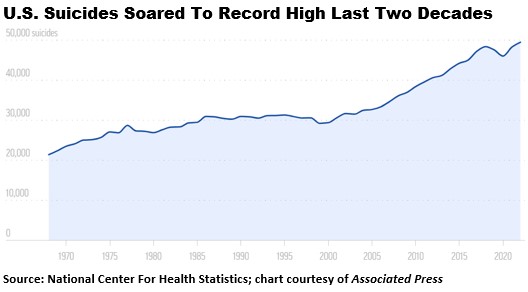Almost 49,500 people took their own lives last year in the U.S., the highest number ever, according to new government data posted in August.
The Centers for Disease Control and Prevention, which posted the numbers, has not yet calculated a suicide rate for the year, but available data suggests suicides are more common in the US than at any time since the dawn of World War II.
US suicides steadily rose from the early 2000s until 2018, when the national rate hit its highest level since 1941. That year saw about 48,300 suicide deaths — or 14.2 for every 100,000 Americans.
The rate fell slightly in 2019. It dropped again in 2020, during the first year of the COVID-19 pandemic. Some experts tied that decline to a phenomenon seen in the early stages of wars and natural disasters, when people pull together and support each other.
But in 2021, suicides rose 4%. Last year, according to the latest data, the number jumped by more than 1,000, to 49,449 — about a 3% increase vs. the year before. The provisional data comes from US death certificates and is considered almost complete, but it may change slightly as death information is reviewed in the months ahead.
The largest increases were seen in older adults. Deaths rose nearly 7% in people ages 45 to 64, and more than 8% in people 65 and older. White men, in particular, have very high suicide rates, the CDC said. More middle-aged and elderly people experience problems like losing a job or losing a spouse, etc. which can lead to depression and thoughts of suicide.
Suicides in adults ages 25 to 44 grew about 1%. While that is certainly better than the suicide rate among older adults, it is nonetheless very concerning. The new data indicates that suicide became the second leading cause of death in this age group in 2022, up from No. 4 in 2021.
Despite the grim statistics, some say there is reason for optimism. A national crisis hotline launched a year ago allows anyone in the US to dial 988 to reach mental health specialists.
The CDC is expanding a suicide program to fund more prevention work in different communities. And there’s growing awareness of the issue and that it’s OK to ask for help, health officials say.
Especially encouraging, there was a more than 8% drop in suicides in people ages 10 to 24 in 2022. That may be due to increased attention to youth mental health issues and a push for schools and other institutions to focus on the problem, CDC officials said.
Firearms were involved in more than half of all suicides in 2022, the provisional data shows. A separate report, published in June by the Johns Hopkins Center for Gun Violence Solutions, found that gun-related suicides were the driving factor behind the recent rise in suicide rates overall.
The rate of suicides involving guns rose 10% between 2019 and 2021, while the rate for those that did not involve guns actually dropped 8% in the same timeframe. White men, especially those 65 and older, were most at risk of gun suicide in 2021, according to the Johns Hopkins report.
Here is another troubling statistic I ran across in working on this article: Nine out 10 adults in the US think the country is experiencing a mental health crisis, according to a survey conducted by CNN in partnership with the Kaiser Family Foundation.
More than 1 in 5 adults described their own mental health as only “fair” or “poor,” including extra-large shares of adults under the age of 30. A third of all adults said they felt anxious always or often over the course of the past year. About 1 in 5 adults said they were often or always depressed or lonely over the past year, too.
Fortunately, there are things everyone can do to help people who are struggling with suicidal thoughts. Researchers say most people considering suicide give off signs that should concern family and friends. The experts agree the most important thing you can do is talk to them about your concerns.
Doing this may be difficult, and you may worry that voicing your concerns will not be received well by the person you are hoping to help. While this is certainly true in many cases, it is still important to reach out even if the reaction is not positive.
Above all, we need to express our concerns and let these family and friends know we will be there for them to help in any way we can.
While government help programs are useful for some considering suicide, this is a crisis which will more likely be controlled with us paying more attention to loved ones around us, and then being more proactive in discussing it with them.



Sorry, comments are closed for this post.